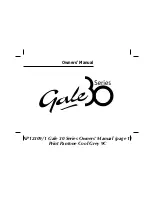
tion trials. If no flame is present at the flame sensor
within 10 seconds, the spark and gas valve will be
de-energized. A 15 second inter-purge period begins
and the combustion blower continues to run. After
the inter-purge period another ignition trial will take
place.
3. If burner fails to light or prove the flame sensor fol-
lowing the two additional trials the control will go into
lockout. The valve relay in the IC will be de-energized
shutting of the gas valve immediately and the com-
bustion blower following a 30 second post-purge
period.
Recovery from Lockout
1. If the thermostat (controller) is still calling for heat one
hour after a lockout occurs, the control will automati-
cally reset and initiate a call for heat sequence.
2. The ignition control may also be manually reset, by
turning the thermostat (controller) down and back up
to previous temperature setting or removing power
(24V) to IC terminal 24 VAC.
Fault Conditions and LED Key
LED Steady On
Internal control fault
1 Flash
Combustion airflow fault
2 Flash
Flame with no call for heat
3 Flash
Ignition lockout
LED flashes on for ¼ second, and off for ¼ second dur-
ing fault condition. Pause between fault codes is three
seconds.
1. If, during the initial call for heat, the air switch con-
tacts are closed for 30 seconds without an output to
the combustion blower, an airflow fault occurs (one
LED flash) and control will remain in this mode.
2. If the airflow switch remains open (or a rollout switch
is open) for more than 30 seconds after the combus-
tion blower output (IND) is energized, an airflow fault
occurs (one LED flash) and control will stay in this
mode with combustion blower on, waiting for airflow
switch (or rollout) to close.
3. If the airflow signal is lost during operation, the
control immediately de-energizes the gas valve
and maintains blower operation. If the call for heat
remains and proper airflow is not detected, an air-
flow fault occurs (one LED flash). If proper airflow is
detected at any time, the normal sequence will begin
with pre-purge.
4. If the main valve fails to close properly at the end of
a heating cycle and a flame is maintained, the com-
bustion blower will continue in operation. If the valve
does close completely later, removing the flame sig-
nal, the blower will run for the post-purge period and
shut off.
5. Refer to Table K3 for further LED code
troubleshooting.
MH Sequence of Operation – 20–100%
Modulation with Two-speed Controller
Fenwal 35-61 Series Direct Ignition Control, TR1
Timer Relay Control and SC30 Modulation Control
When system is powered up 24 VAC will be applied to the
ignition control (IC) terminals 24 VAC/R and to the timer
relay control (TR1). The ignition control will reset, perform
a self-check routine, initiate full time flame sensing, flash
the diagnostic LED for up to four seconds and enter the
thermostat scan standby state. The amber light on the
TR1 will be lit indicating it is in the ready position.
Call for Heat
1. Thermostat (heat enable) closes on call for heat.
2. 24 VAC to is supplied to IC terminal TH, provided
limit switch is in closed position.
3. The control will check that pressure switch contacts
are open (IC terminal PSW is not powered).
4. Combustion blower is then energized at high speed.
5. When the air switch (APS1) closes, a 15 second pre-
purge period begins.
6. At end of pre-purge period, the spark begins and the
first stage and second stage gas valves are ener-
gized for the trial for ignition period.
7. TR1 is powered (terminal 7) simultaneously (SR LED
lit) and begins timing a 90 second warm-up period
while maintaining the combustion blower at high
speed (FR LED lit) and powers the SC30. The SC30
will output 12 to 13 VDC to the modulating control
valve during the timing duration (90 seconds) of TR1,
regardless of the analog input signal to SC30 termi-
nals 7 and 8.
8. Burners ignite at an intermediate high fire condition
(manifold pressure 2.5” w.c. or higher; the SC30
control provides 12.5 to 13.0 VDC to modulating
valve) and cross light.
9. When flame is detected by flame sensor, the spark
is shut off and gas valve(s) and combustion blower
remains energized.
10. When the initial timer in TR1 times out, it defaults the
gas valve to low fire and the combustion blower to
low speed and returns control of the operating mode
to the building temperature controller. The SR LED
turns off and the MR LED is lit.
11. If the controller is providing an analog signal between
0.5 and 5.3 VDC to the SC30 control, the system will
continue to run at low speed combustion blower and
with only the first stage valve open. The modulating
valve will be powered proportional to the input volt-
age signal from the controller, and will open or close
changing the gas manifold pressure. Manifold pres-
sure will vary from 0.3” w.c. to 1.2“ w.c. operating in
this mode.
VCES-VHC-IOM-1F – VHC-36, -42 & -50
75
















































